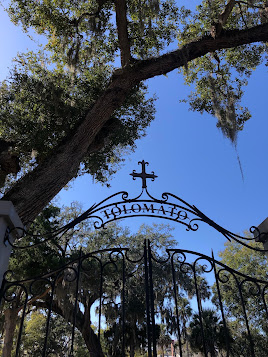St. Augustine, Florida
February 24, 2022
Tolomato Cemetery is located near the original gates of the town of St. Augustine, and around 1,000 Augustinians are buried within its one acre site. It was originally a Franciscan mission in the First Spanish Period, before becoming a cemetery in the 18th century. The cemetery was in use all the way until the late 1800s. The individuals laid to rest in the cemetery make up the diverse cultural background of St. Augustine, and in a way tell the story of the town itself, from its Spanish settlement all the way to Florida officially becoming the 27th state admitted to the American union.
Official website: http://www.tolomatocemetery.com/
Exterior Image 1
Exterior Image 2
Artifact Image 1
This marble monument was created by H.T. Baya to honor his wife, Mary Carmen Benet Baya, as well as his four children, Agnes, Franklin, Louise, and an infant also named Mary Carmen. By the late 1860s, most of the family had tragically passed away, with Mary dying due to complications from childbirth. H.T. Baya lived for several decades after creating this monument before passing away himself in 1912.
Artifact Image 2
This is an open bronze book inside the distinctive white chapel at the back of the cemetery commemorating the 500th anniversary of the discovery of Florida, as well as the 450th anniversary of St. Augustine's founding with bishop H.E. Felipe De Jesus Estevez. It also celebrates the visit of Jose Marti, who is regarded as the apostle of Cuban independence. Perhaps most notably, the book mentions Father Felix Varela, who was buried in 1853 in this chapel built specifically for him by his students in Havana and his friends from New York City. The left page is in English with an American flag behind it, while the right page is in Spanish with a Cuban flag behind it.
Image in Conversation 1
Image in Conversation 2
Literature in Conversation
Craig Santos Perez's "[lukao]" discusses the native Guam practice of burying the placenta and umbilical cord following the birth of a child, and how this practice was challenged by new American laws. He writes, "U.S. Naval orders mandated that the placenta and umbilical cord be burned because they were considered hazardous waste." (Perez, 69). This reminded me of how cemeteries eventually are filled and cannot contain any more of the deceased, such as what happened to Tolomato in 1884. At this stage, just like the aforementioned "placental politics", cremation becomes a common alternative to the traditional burial, and it has since come into semi-common practice in the United States. Nonetheless, some still desire to be buried in specific locations upon their death, and are committed to having their wish fulfilled, even if it goes against established law.
Creative Component











No comments:
Post a Comment